Gender/ Sexuality
by Chloe Martens

1. Sexual Orientation
1.1. -This describes who we are sexually attracted to and is often determined at a young age
1.2. Asexuals: not attracted to people of any sex
1.3. Bi/omni/pansexuals- attracted to some member of both/ all sexes to varying degrees
1.4. heterosexuals- primarily attracted to some members of another sex
1.5. Homosexuals- primarily attracted to some persons of the same sex
1.6. -Sexual Orientation is also on a spectrum. You may be attracted to both sexes but maybe one more than the other.
1.7. -Everyone is different
2. Sexual Behavior
2.1. Definition: term used to describe the types of sexual activities an individual actually engages in.
2.2. This is different from who someone is romantically attracted to. You can be in love with someone because they are your best friend but are not sexually attracted to this person
2.3. "Since behavior can be chosen, people may choose to engage in certain behaviors and not others". This proves that sexual behavior is not always determined by sexual orientation
3. Labels
3.1. -The term gay came as a way to describe men in a same sex relationship. However, women are also described as gay but often prefer the term Lesbian
3.2. Most people when they think of homosexuality they just think of gay and lesbian but that is not always true. Homosexuality refers to an array of individuals who do not specifically identify as being gay or lesbian
3.3. Many people that do not want to specify as gay or Lesbian prefer to be referred as bi-curious, fluid, hetero-flexible, homo-flexible, open, omni-sexual, pan-sexual, polyamorous, questioning, or queer
4. Gender as a social construct
4.1. Most people believe that there has always been two genders. That God or whoever created only two genders and anything beyond this is out of the norm. However, society has made us believe there are only two genders when in actuality that's not true
4.2. If you think of gender as a social construct than you can break that barrier down
4.3. Most people are assigned a gender at birth based on the genitalia they process. It is societal pressure that makes parents determine the sex of their baby at such a young age. Often it is required at the hospitals to write down the sex of the baby.
5. Gender Norms
5.1. Women/ young girls: Docile, delicate, like pink or purple, often hormonal, irrational, sexualized, weak, powerless, often shamed for showing too much of their body, etc.
5.2. Men/young boys: strong, rambunctious, adventurous, powerful, Horney, aggressive, good with their hands, can fix anything, likes sports, plays sports, etc.
5.3. THERE ARE NOT SPECIFICALLY TWO GENDERS AND GENDER NORMS ARE DUMB!
6. Gender/ Sexual Identity
6.1. -Gender Identity is on a spectrum
6.2. -When people are born they are assumed to be a certain gender based on social norms. This can either be male or female. However, most people don't like to identity with one specific gender or they believe that gender shouldn't be used to identity someone.
6.3. -This is how you see yourself in your mind. It is what you believe is your true identity.
6.4. This also goes hand and hand with sexual identity: often the process of an identity formation can be long and complex
6.5. Transgender: This is a term used to describe people that are not cisgender, or who gender identity is different from the sex that they were assigned to at birth
6.6. Intersex: a term used to describe someone at birth that was not specifically determined as male or female. Doctors often pressured parents to determine the sex of the baby before leaving the hospital.
7. Sexuality
7.1. Definition: term that is used to refer to an individual's tendencies, preferences, and desires with respect to romantic partners and intimate relationships
7.2. -Everyone has sexuality and this is often used to describe a range of internal identities and external behaviors
8. Pronouns
8.1. -Many people do not want to identify with the heteronormative pronouns of he/his or she/her/hers
8.2. For people who identify themselves as non-binary they will often use they/ them, ze, hir, hirs etc.
8.3. Non- binary: is a spectrum of gender identities that are not exclusively masculine or feminine—identities that are outside the gender binary
9. In the Media
9.1. Children are not born into this world already knowing social norms of the society. For example, that girls are suppose to wear pink, play with barbies, etc. and boys are suppose to be rascals that play with trucks
9.2. Children are taught that based on what gender they identify with they need to act this specific way. Young girls are taught to be delicate while boy are taught to be adventurous
9.3. Media also teaches young children how to act a certain way based on their gender. TV shows, movies, magazines, commercials all contribute to socializing gender
9.4. In magazines you can see the man looking strong while the women looks docile and weak.
9.5. This opened my eyes to a lot of things I had seen in the media at such a young age. I didn't realize how much I was conditioned to act a certain way based on my gender.
10. Gender expression
10.1. The way you present gender through actions, demeanor, dress, and how those presentations are based on gender norms
10.2. Most people just assume how someone identifies themselves based on gender. Assuming is dangerous and can be hurtful to the person.
10.3. You can often ask how someone would like to be identified if you are confused.


